Defending the Golden Gate
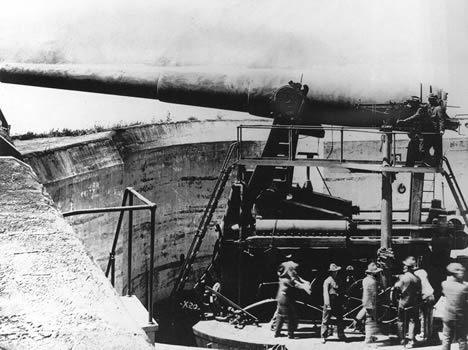
Battery Lancaster, the northernmost of Fort Winfield Scott's coastal defense batteries, was part of a chain of fortifications that spanned the Golden Gate.
Battery Lancaster's mission was unique, among the many artillery installations on this bluff. From 1900 through World War I, Lancaster's three guns offered the only artillery coverage from the south for the narrowest part of the harbor entrance.
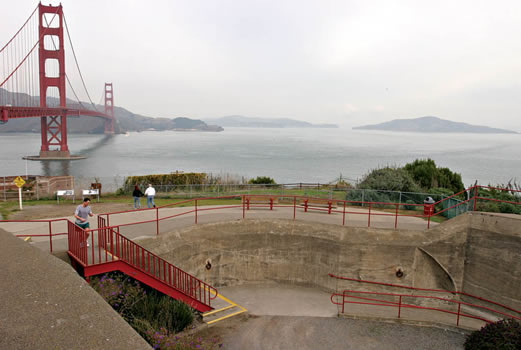
In addition to the gun pit, and the two gun emplacements, Battery Lancaster featured several underground rooms and ammunition magazines. Most of these were buried or destroyed by construction of the Golden Gate Bridge in the early 1930s. However, portions survived and the battery saw service again during World War II.
Following the attack on Pearl Harbor, soldiers were sent to defend the Bridge. The commanding officer selected flat ground near the toll plaza for the company's antiaircraft guns and set up his headquarters, and quarters for his soldiers, in what remained of Battery Lancaster.
World War II Defenses
Under the command of Captain Harry Freeman, World War II troops protected the Golden Gate Bridge with antiaircraft guns and lived in Battery Lancaster, in underground rooms beneath the Bridge toll plaza.
More Images
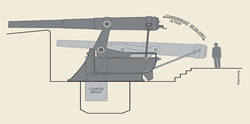 |
The 12-inch rifles installed in Battery Lancaster in 1900 were mounted on carriages that enabled them to drop down behind the battery's parapet and out of the enemy's sight after firing.
These breech-loading guns were declared obsolete and removed in 1918.
|
 |
Ropes were pulled through these metal rings located around the battery in order to maneuver the heavy guns into position.
|
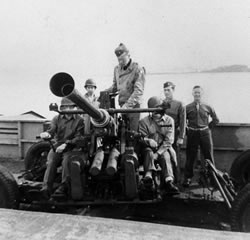 |
Antiaircraft gun
|
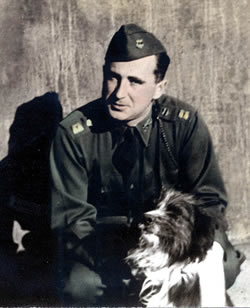 |
Captain Harry Freeman and company mascot, circa 1942. |
Explore this Topic Further
Battery Lancaster
Battery Lancaster History and Armaments (grades 3 to adult)
This provides a short history of Battery Lancaster and details about the three 12-inch disappearing guns used in the battery. It also provides a plan of the battery dating to 1919.
Fort Winfield Scott
Fort Scott: Defending the Coastline from the Presidio Trust (grades 3 to adult)
This web site provides a brief history of Fort Winfield Scott from the beginning of its construction in 1908 through its use as the Nike missile Air Defense School after World War II. It includes photos of Army personnel at the site and links to photos of some of the officer housing constructed at the fort.
Fort Winfield Scott History from National Park Service (grades 3 to adult)
This provides a very brief history of Fort Winfield Scott, which opened on June 19, 1912, as the headquarters of the Artillery District of San Francisco and later became the headquarters of the Coast Defenses of San Francisco.
Fort Scott Batteries Map from National Park Service (grades 3 to adult)
This map and interactive list provides short descriptions, photographs, and directions to the fifteen of the Endicott-era gun batteries that were housed at Fort Scott.
Fort Winfield Scott Endicott Era Batteries (grades 3 to adult)
This web site provides an interactive list of all of the Endicott era batteries at Fort Winfield Scott along with photos and details about when they were in service, how much they cost to construct, and the caliber of the guns.
Endicott Era Fortifications
Harbor Defenses of San Francisco, Endicott Era from National Park Service (grades 3 to adult)
This web site provides a short history of the development of the forts, batteries, and guns installed to protect San Francisco Bay by the Board on Fortifications or Other Defenses under the direction of Secretary of War William C. Endicott and later Secretary of War William Taft.
US Forts - Endicott Period (1890-1910) (grades 3 to adult)
This web site provides an interactive map and list of 81 Endicott era forts established in the United States. Links contain photos, and short history, and a details about the batteries at each fort.
The Disappearing Gun of Battery Chamberlin (all ages)
This video shows National Park Service employee and volunteers demonstrating the steps of loading and aiming the 6-inch disappearing gun at Battery Chamberlin, which is done the first weekend of each month. This is 6-inch rifle is smaller than the 12-rifles in Battery Lancaster. Battery Chamberlin is located at the north end of the Baker Beach parking lot. (2:34 minute video)
World War II - San Francisco Bay
World War II Harbor Defenses from National Park Service (grades 3 to adult)
This web site provides a map of installations and links to descriptions of the various systems that were used to defend San Francisco Bay during World War II. These include Fort Cronkhite, the San Francisco Port of Embarkation, the guns, the mines, and the submarines.
* Note: This display is not part of the NSF-funded Golden Gate Bridge Outdoor Exhibition project